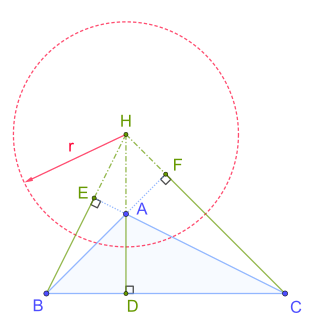Top Qs
Timeline
Chat
Perspective
Polar circle (geometry)
Unique circle centered at a given triangle's orthocenter From Wikipedia, the free encyclopedia
Remove ads
In geometry, the polar circle of a triangle is the circle whose center is the triangle's orthocenter and whose squared radius is

Reference triangle △ABC
Polar circle of △ABC, centered at H
where A, B, C denote both the triangle's vertices and the angle measures at those vertices; H is the orthocenter (the intersection of the triangle's altitudes); D, E, F are the feet of the altitudes from vertices A, B, C respectively; R is the triangle's circumradius (the radius of its circumscribed circle); and a, b, c are the lengths of the triangle's sides opposite vertices A, B, C respectively.[1]: p. 176
The first parts of the radius formula reflect the fact that the orthocenter divides the altitudes into segment pairs of equal products. The trigonometric formula for the radius shows that the polar circle has a real existence only if the triangle is obtuse, so one of its angles is obtuse and hence has a negative cosine.
Remove ads
Properties

Circumcircle of tangential triangle
(s; centered at K)
(s; centered at K)
Polar circle of △ABC
(d; centered at orthocenter H)
The centers of these circles relating to △ABC are all collinear–they fall on the Euler line.
(d; centered at orthocenter H)
Any two polar circles of two triangles in an orthocentric system are orthogonal.[1]: p. 177
The polar circles of the triangles of a complete quadrilateral form a coaxal system.[1]: p. 179
The most important property of the polar circle is the triangle is self-polar; the polar of each side/point is the opposite side/point.
A triangle's circumcircle, its nine-point circle, its polar circle, and the circumcircle of its tangential triangle are coaxal.[2]: p. 241
Remove ads
References
External links
Wikiwand - on
Seamless Wikipedia browsing. On steroids.
Remove ads

![{\displaystyle \displaystyle {\begin{aligned}r^{2}&={\overline {HA}}\times {\overline {HD}}={\overline {HB}}\times {\overline {HE}}={\overline {HC}}\times {\overline {HF}}\\[4pt]&=-4R^{2}\cos A\cos B\cos C\\[4pt]&=4R^{2}-{\frac {a^{2}+b^{2}+c^{2}}{2}}\end{aligned}}}](http://wikimedia.org/api/rest_v1/media/math/render/svg/324e26fa5cbad3b3df49752b826167addcf416da)